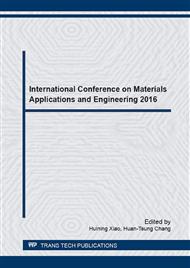[1]
A. Sozinov, A. A. Likhachev, N. Lanska, K. Ullakko, Crystal structures and magnetic anisotropy properties of Ni-Mn-Ga martensitic phases with giant magnetic-field-induced strain, Appl. Phys. Lett. 80 (2002) 1746-1748.
DOI: 10.1109/intmag.2002.1000720
Google Scholar
[2]
T. Kakeshita, K. Ullakko, MRS Bull. Giant magnetostriction in ferromagnetic shape-memory alloys 27(2002) 105-109.
DOI: 10.1557/mrs2002.45
Google Scholar
[3]
L. Gao, W. Cai, A. L. Liu, L. C. Zhao, Preparation and characterization of Ni-Mn-Ga high temperature shape memory alloy thin films using rf magnetron sputtering method, J. Alloy. Compd. 425 (2006) 314-317.
DOI: 10.1016/j.msea.2006.01.115
Google Scholar
[4]
S. H. Guo, Y. H. Zhang, Z. Q. Zhao, Y. Qi, B. Y. Quan and X. L. Wang, Effects of Sm on phase transformation in Ni-Mn-Ga alloys, J. Rare Earth 22 (2004) 875-877.
Google Scholar
[5]
K. Tsuchiya, A. Tsutsumi, H. Ohtsuka, M. Umemoto, Modification of Ni-Mn-Ga ferromagnetic shape memory alloy by addition of rare earth elements, Mater. Sci. Eng. A 378 (2004) 370-376.
DOI: 10.1016/j.msea.2003.11.076
Google Scholar
[6]
H. B. Wang, F. Chen, Z. Y. Gao, W. Cai, L. C. Zhao, Effect of Fe content on fracture behavior of Ni-Mn-Fe-Ga ferromagnetic shape memory alloys, Mater. Sci. Eng. A 438-440 (2006) 990-993.
DOI: 10.1016/j.msea.2006.01.101
Google Scholar
[7]
S. Y. Yang, Y. Liu, C. P. Wang, Z. Shi, X. J. Liu, The mechanism clarification of Ni-Mn-Fe-Ga alloys with excellent and stable functional properties, J. Alloy. Compd. 560 (2013) 84-91.
DOI: 10.1016/j.jallcom.2013.01.128
Google Scholar
[8]
D. Y. Cong, S. Wang, Y. D. Wang, Y. Ren, L. Zuo, C. Esling, Martensitic and magnetic transformation in Ni-Mn-Ga-Co ferromagnetic shape memory alloys, Mater. Sci. Eng. A 473 (2008) 213-218.
DOI: 10.1016/j.msea.2007.03.088
Google Scholar
[9]
Y. Y. Li, J. M. Wang, C. B. Jiang, Study of Ni–Mn–Ga–Cu as single-phase wide-hysteresis shape memory alloys, Mater. Sci. Eng. A 528, 6907-6911 (2011).
DOI: 10.1016/j.msea.2011.05.060
Google Scholar
[10]
S. Stadler, M. Khan, J. Mitchell, N. Ali, A. M. Gomes, I. Dubenko, A.Y. Takeuchi, A.P. Guimarães, Magnetocaloric properties of Ni2Mn1-xCuxGa, Appl. Phys. Lett. 88 (2006) 192511.
DOI: 10.1063/1.2202751
Google Scholar
[11]
I. Glavatskyy, N. Glavatska, A. Dobrinsky, J. -U. Hoffmann, O. Söderberg, S. -P. Hannula, Crystal structure and high-temperature magnetoplasticity in the new Ni-Mn-Ga-Cu alloys, Scripta Mater. 56 (2007) 565-568.
DOI: 10.1016/j.scriptamat.2006.12.019
Google Scholar
[12]
C. B. Jiang, J. M. Wang, P. P. Li, A. Jia, H. B. Xu, Search for transformation from paramagnetic martensite to ferromagnetic austenite: NiMnGaCu alloys, Appl. Phys. Lett. 95, 012501 (2009).
DOI: 10.1063/1.3155199
Google Scholar
[13]
S. Roy, E. Blackburn, S. M. Valvidares, M. R. Fitzsimmons, S. C. Vogel, M. Khan, I. Dubenko, S. Stadler, N. Ali, S. K. Sinha, J. B. Kortright, Delocalization and hybridization enhance the magnetocaloric effect in Cu-doped Ni2MnGa, Phys. Rev. B 79 (2009).
DOI: 10.1103/physrevb.79.235127
Google Scholar
[14]
G. J. Li, E. K. Liu, H. G. Zhang, Y. J. Zhang, G. Z. Xu, H. Z. Luo, H. W. Zhang, W. H. Wang, G. H. Wu, Role of covalent hybridization in the martensitic structure and magnetic properties of shape-memory alloys: The case of Ni50Mn5+xGa35-xCu10, Appl. Phys. Lett. 102 (2013).
DOI: 10.1063/1.4791701
Google Scholar
[15]
M. Zelený, A. Sozinov, L. Straka, T. Björkman, R. M. Nieminen, First-principles study of Co- and Cu-doped Ni2MnGa along the tetragonal deformation path, Phys. Rev. B 89 (2014) 184103.
DOI: 10.1103/physrevb.89.184103
Google Scholar
[16]
J. Hafner, Atomic-scale computational materials science, Acta Mater. 48 (2000) 71-92.
Google Scholar
[17]
G. Kresse, J. Furthmüller, Efficient iterative schemes for ab initio total-energy calculations using a plane-wave basis set, Phys. Rev. B 54 (1996) 11169-11186.
DOI: 10.1103/physrevb.54.11169
Google Scholar
[18]
G. Kresse, J. Joubert, From ultrasoft pseudopotentials to the projector augmented-wave method, Phys. Rev. B 59 (1999) 1758-1775.
DOI: 10.1103/physrevb.59.1758
Google Scholar
[19]
J. P. Perdew, Y. Wang, Accurate and simple analytic representation of the electron-gas correlation energy, Phys. Rev. B 45 (1992) 13244-13249.
DOI: 10.1103/physrevb.45.13244
Google Scholar
[20]
H. J. Monkhorst, J. D. Pack, Special points for Brillouin-zone integrations, Phys. Rev. B 13 (1976) 5188-5192.
DOI: 10.1103/physrevb.13.5188
Google Scholar
[21]
J. Bai, J. M. Raulot, Y. D. Zhang, C. Esling, X. Zhao, L. Zuo, Crystallographic, magnetic, and electronic structures of ferromagnetic shape memory alloys Ni2XGa (X=Mn, Fe, Co) from first-principles calculations, J. Appl. Phys. 109 (2011) 014908.
DOI: 10.1063/1.3524488
Google Scholar


